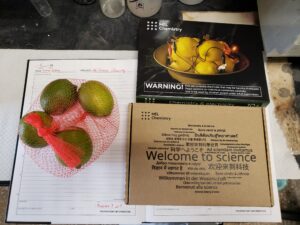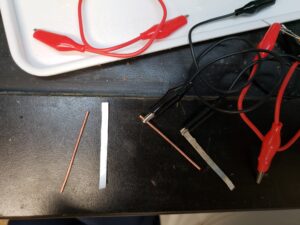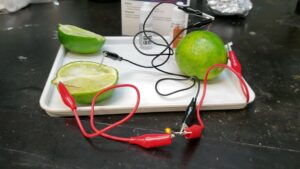Here’s kit three to the Mel Science Chemistry experiments. Read about the last set of experiments here [1].
This kit explores the basics of what makes an electrochemical cell, or battery. Batteries are widely used in our everyday life, from handheld remote controls, to the smart phone and even electric vehicles. On October 9 (today!), pioneers in the battery field were awarded the Nobel Prize in Chemistry for their work in Lithium ion batteries [2] (and here [3]), some of the most advanced, pack full of punch and power cells we have in our modern era.
Upon receiving this kit and buying lemons from the local Taiwanese grocery store, I was immediately struck by the difference in the cover image (yellow peel lemons) and the ones I obtained (greener). Some day when I am able to get my hands on yellow peel lemons I think it’d be fun to check the acidity difference to greener ones!


To start running these experiments, I obtained a bag of lemons and opened the kit, which comes with the crocodile clips, electrodes, and chemicals needed. Safety is always important and the kit also comes with two pairs of gloves (and eye-wear from the starter kit). I also made sure to write down the local hospital contact number for emergencies and poison mitigation as instructed in the manul (despite the relative safety, this is good practice to check and follow before beginning each and every experiment). For this experiment I still had my lab-coat on and worked under the fume hood, though I could have also done this experiment outside in the sunshine.
The lemon is chock full of citric acid, C6H8O7, and probably water too. The battery here works because the metallic electrodes supply current in the form of electrons. By giving away electrons, from the less to more electronegative element, the magnesium (Mg) to copper (Cu) in this experiment, an electrical circuit can be formed to power the light. The process of electronic “movement” begins as soon as the electrodes are inserted into the lemon cell, because the liquid juice of the lemon (or termed electrolyte in battery speak) acts as a medium to aid in transport of the needed charge. Turns out 1.03 V at the full lemon are generated, with the circuit set up as in the picture below.
Could other metals have been used in this experiment? The answer is generally yes, as long as we pay attention to the periodic table. A good rule of thumb for choosing electrodes is to consider the reactivity of metals, with Li, at one free electron, the most reactive. The list would look something like Li –> K –> Ba –> Ca –> Mg –> Al –> Zn –> Fe –> Sn –> Pb –> Cu. Mel’s kit choice of Mg to Cu gives a large enough separation, so to speak, between the Mg and Cu so that a suitably sufficient voltage could be generated, (in this case ~0.8 V for the half lemon, with 0.034 V connecting the full and half lemons).

Did I eat the lemon? No, because although some fruits may have traces of these elements, once the Cu and Mg are in the lemon an electro-chemical process begins, potentially leaving the levels of those two metals two high in the fruit.
What if I had no lemons? Other fruits, such as lime or oranges would work (strawberries might work?!), and certainly some liquids such as pepsi or a solution of CuSO4 and ZnSO4 (the galvanic cell) would do the trick.
References
- https://phillip-wu.com/mel-science-chemistry-chemistry-of-eggs/
- https://youtu.be/rgdDPHh_5es
- https://www.nobelprize.org/prizes/chemistry/2019/summary/